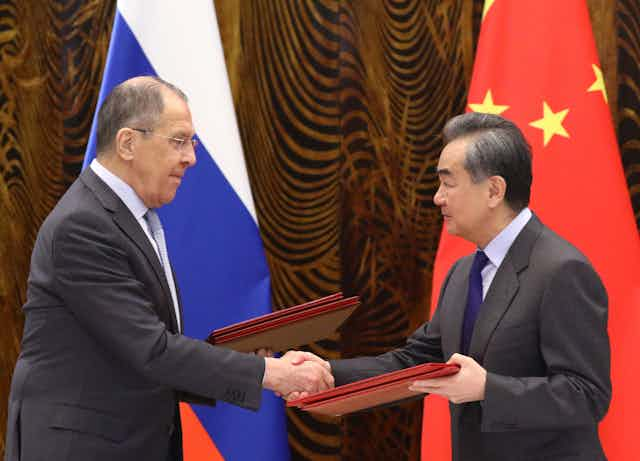Hot on the heels of the US-China talks in Alaska on March 23, Russian foreign minister, Sergei Lavrov, and his Chinese counterpart, Wang Yi, met and signed a declaration clearly aimed at the west, which pledged to reject the politicisation of human rights and interference in their countries’ internal affairs.
Much of the joint statement said nothing new. The two powers have had a “strategic partnership” since 1997, which was cemented by treaty in 2001 – 20 years ago. Coming in the wake of US and EU sanctions on China and renewed sanctions on Russia by the EU, the declaration was a show of solidarity, suggesting that Russia and China could circumvent sanctions by settling payments in national currencies rather than the US dollar.
But, while acknowledging the two powers are strengthening their relationship in the face of pressure from the US and its Nato allies, plenty has happened in the past two decades to change the nature of that partnership. And much of this could prove to be be as divisive as the factors which have brought the two countries together.
The economic relationship between Russia and China remains asymmetric in nature. Russia mainly exports raw materials (chiefly hydrocarbons) to China in exchange for manufactured goods. Russia is just one of many sources of energy supply for China, which also seeks to wean itself off gas in the longer term, but Russia is becoming increasingly dependent on China, as Europe’s share of Russian trade has begun to decrease.
Pressure points
There are potential pressure points in the partnership. One of these is central Asia, where Russia seeks to maintain primacy – and in the longer term, possibly even military influence – in the face of growing Chinese economic influence in the region via infrastructure development through its Belt and Road Initiative (BRI). Indeed, the rollout of the BRI is seen by some as a response to Russia’s curbing of Chinese attempts at economic cooperation within the Shanghai Cooperation Organisation that includes Russia, China, the five central Asian states and also, since 2017, India and Pakistan.
Russia’s response has been to connect its own Eurasian Economic Union with the BRI in a bid to ensure the preservation of Russian influence in Central Asia – although Chinese acquiescence to this plan is widely seen as a ploy to assuage Russian fears of Chinese dominance.

China will seek to protect its economic assets, particularly given its fears regarding terrorism in Xinjiang and now in central Asia. It is already signing various bilateral agreements with central Asian states, and starting to use private security companies in the region, as well as helping Tajikistan to set up patrols near the border with Afghanistan.
Previously Russia and China had well-delineated roles in central Asia, with Russia emphasising political and security aspects, and China pursuing economic cooperation. But China is showing signs of becoming both a more political actor, and more proactive in the security arena.
The Arctic, long seen as an exclusive sphere of interest for Russia, is now designated part of China’s Polar Silk Road. Russia controls transport logistics, but it needs Chinese capital to exploit Arctic energy resources.
In the Indo-Pacific, Russia has already learned to tread carefully. For example, it has assumed an air of studied neutrality on China’s claims in the South China Sea, although this neutrality was tested when Russia’s Rosneft refused to cease drilling in the “Nine-Dash Line” around Vietnam. By the same token, China has also been cautious, offering less than wholehearted support on Crimea, annexed by Russia in 2014, despite recent visits there by Chinese business delegations.
Around their joint border in the Russian far east, low-level tensions regarding what Russia sees as predatory Chinese economic practices continue to erode trust. Russia has long complained about China’s refusal to invest in the region.
The logging industry there is a case in point, as all its timber is processed in Chinese factories just over the border, while Russia provides only raw materials. As China won’t invest in the Russian far east, nor process the timber in Russia, China reaps the profits of the resource. At the same time, the huge Chinese demand for timber has encouraged illegal logging with links to local organised crime groups.
Turn to the east
This type of tension, while not enough to affect the elite relationship, speaks of the fact that Russia’s much-vaunted “turn to the east” is in reality a turn towards China, leaving it no alternative should relations sour.
Although Russia had attempted in 2009 under the then president Dmitry Medvedev, to modernise the economy and ensure energy security by weaning itself off its overemphasis on raw materials, and seeking to diversify relations with other partners in the Asia-Pacific, the policy failed.
Government elites with ties to energy companies were not yet ready to relinquish their rents. Nor has Russia been able to implement many of its ambitious plans for its ailing far eastern region, which was once central to the Asian pivot. By continuing with its Sinocentric approach, Moscow ensures the continuing overdependence on China, and so the impossibility of modernisation and diversification of the economy.
Overall, this latest foreign ministerial meeting, despite appearing to be a new page in Russia-China relations, merely underscores pre-existing positions. For both Russia and China, strategic ambiguity has worked best in terms of preserving room for manoeuvre – after all, alliances can lead to entrapment. But attempts by the west to move Russia away from China are unlikely to succeed. Despite tensions in some areas, there is more to them than anti-western sentiment alone.

